BELFAST City Cemetery’s Visitor Centre officially opened its doors today.
The centre includes an interpretive exhibition, digital touchscreens, interactive features for children, genealogy research workstations and indoor and outdoor educational space for schools and youth groups.
The fruits of meticulous investment and planning which stretched back over a decade, the project has now achieved completion despite encountering some roadbumps along the way — in particular a hullaballoo over omitting Irish language signage.
Speaking after a Council U-turn resulted in the erection of signage in Irish, Cuisle Nic Liam of An Dream Dearg said the local community felt vindicated.
“The local community rightly challenged that planning decision, and a campaign began to ensure the centre was reimagined as a fully bilingual resource for local people, schools and visitors," she said.
"The progress made is testament to the local Irish language community who stood their ground in what became a litmus test of Belfast City Council’s commitment to the Irish language in public and shared spaces."
The newly opened centre is part of a £2.8 million heritage project funded by The National Lottery Heritage Fund, Belfast City Council and the Department for Communities.
Speaking as the centre opened Lord Mayor Councillor Christina Black said the facility would transform how the public engages with the cemetery: “City Cemetery opened in 1869, and it is the final resting place of many notable figures including Sir Edward Harland, co-founder of Harland & Wolff; Margaret Byers, suffragist and founder of Victoria College; and Sir William Pirrie, chairman of Harland & Wolff in the Titanic era," she said. "Their stories, the history of the cemetery and the wider development of the city of Belfast are all told within the new visitor centre.
“This project aims to transform how people view and use the cemetery, ensuring that visitors can appreciate the wealth of history and heritage within its walls. In addition to the new visitor centre, interpretive signage is being installed throughout the cemetery and visitors can download an app so they can take self-guided tours.”
Dr Paul Mullan from The National Lottery Heritage Fund said the project would "safeguard important local heritage".
"We’re looking forward to the unveiling of the Cemetery’s fascinating, historic features in the coming months when restoration works are complete.”
Mar a thosaigh sé ➡️ mar a d’fhorbair sé ➡️ mar a chríochnaigh sé 😍⭕️
— An Dream BánDearg 🅾️🦸🏽♀️🦸🏻♂️ (@dreamdearg) December 16, 2022
How it started ➡️ how it developed ➡️ how it finished 😍⭕️
Great to see new external bilingual signage at @belfastcc City Cemetery Visitor Centre!
Más mall is mithid 🥳⭕️ pic.twitter.com/uGgjHhmsUa
The final key elements of the project will see the restoration of several historic B1-listed monuments including the cemetery’s central steps and vaults and Victorian fountains, as well as the installation of new interpretive signage in Irish later this year.
Initially the new visitor centre will be open five days a week from Tuesday to Saturday from 10.30am to 1.30pm.







